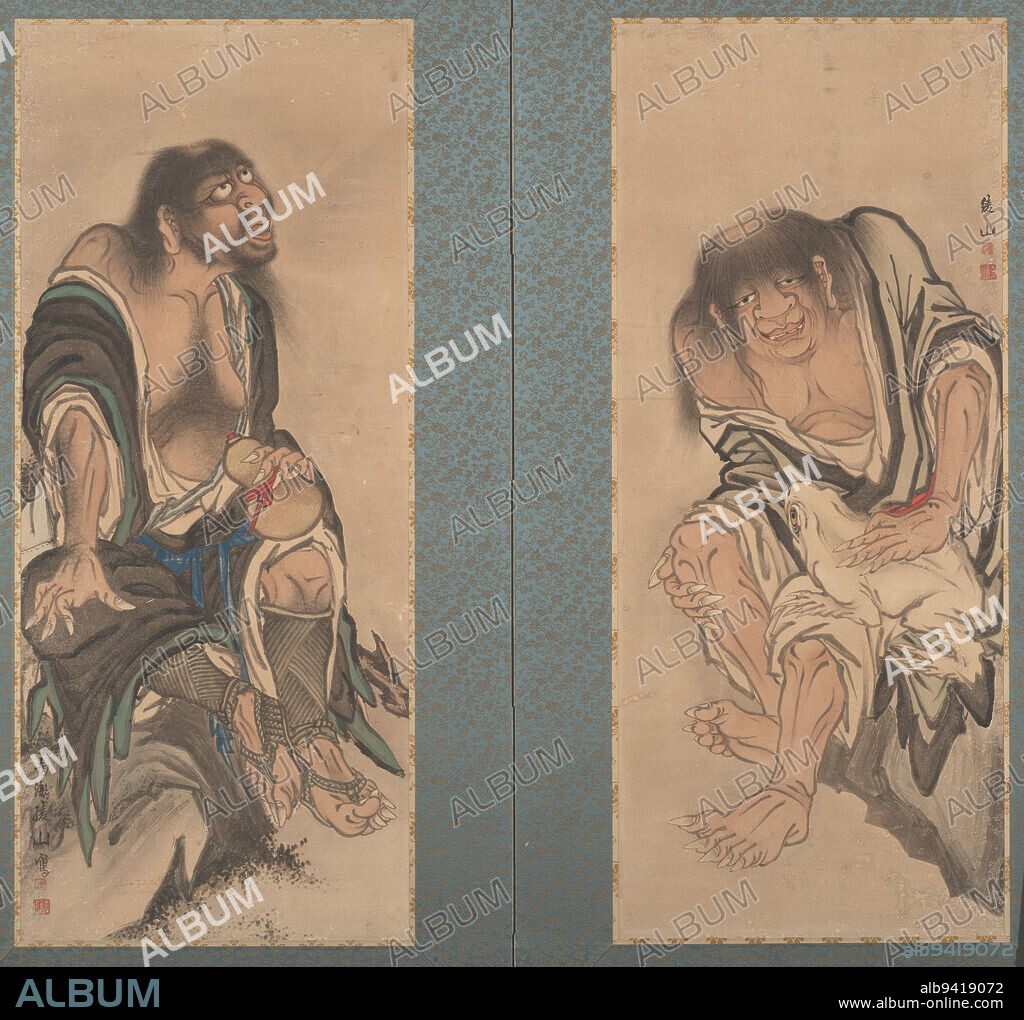alb9419072
The Immortals Gama Sennin and Tekkai Sennin, early 19th century, Kuroda Ryzan, Japanese, 1755 - 1814, 52 3/4 × 22 5/16 in. (133.99 × 56.67 cm) (image, L screen)52 13/16 × 22 5/16 in. (134.14 × 56.67 cm) (image, R screen)66 3/4 × 69 5/8 × 11/16 in. (169.55 × 176.85 × 1.75 cm) (mount), Two-panel folding screen; ink and light colors on paper, Japan, 19th century, This two-panel screen depicts the Daoist immortals, Gama Sennin (Chin. Liu Hai) and Tekkai Sennin (Chin. Li Tieguai). The two were often paired in Japanese and Chinese art because of their corresponding supernatural powers. Depicted on the right is Gama Sennin, known literally as the toad hermit, a character based on the historical civil servant and alchemist Liu Hai of 10th century China. Various accounts associate Gama with a large, three-legged toad by which he can be identified. Gama was thought to be able to release his spirit from his body, metamorphose, and fly with the aid of his magical companion. Chinese prototypes of this theme sometimes represent the immortal sitting on or resting his foot on the animal and holding a string of gold coins, with which he is supposed to have lured the toad from its hiding place in a well. Here, however, Kuroda Ryzan has depicted the relationship between his subjects as one of affection rather than of conquest. Gamas flattened head, broad nose, and wide grin convey an eccentric character and otherworldly nature.

|
Añadir a otro lightbox |
|
Añadir a otro lightbox |



¿Ya tienes cuenta? Iniciar sesión
¿No tienes cuenta? Regístrate
Compra esta imagen.
Selecciona el uso:

Descripción:
Ver traducción automática
The Immortals Gama Sennin and Tekkai Sennin, early 19th century, Kuroda Ryzan, Japanese, 1755 - 1814, 52 3/4 × 22 5/16 in. (133.99 × 56.67 cm) (image, L screen)52 13/16 × 22 5/16 in. (134.14 × 56.67 cm) (image, R screen)66 3/4 × 69 5/8 × 11/16 in. (169.55 × 176.85 × 1.75 cm) (mount), Two-panel folding screen; ink and light colors on paper, Japan, 19th century, This two-panel screen depicts the Daoist immortals, Gama Sennin (Chin. Liu Hai) and Tekkai Sennin (Chin. Li Tieguai). The two were often paired in Japanese and Chinese art because of their corresponding supernatural powers. Depicted on the right is Gama Sennin, known literally as the toad hermit, a character based on the historical civil servant and alchemist Liu Hai of 10th century China. Various accounts associate Gama with a large, three-legged toad by which he can be identified. Gama was thought to be able to release his spirit from his body, metamorphose, and fly with the aid of his magical companion. Chinese prototypes of this theme sometimes represent the immortal sitting on or resting his foot on the animal and holding a string of gold coins, with which he is supposed to have lured the toad from its hiding place in a well. Here, however, Kuroda Ryzan has depicted the relationship between his subjects as one of affection rather than of conquest. Gamas flattened head, broad nose, and wide grin convey an eccentric character and otherworldly nature.
Personas:
Crédito:
Album / quintlox
Autorizaciones:
Tamaño imagen:
5941 x 5612 px | 95.4 MB
Tamaño impresión:
50.3 x 47.5 cm | 19.8 x 18.7 in (300 dpi)
Palabras clave:
AFECTO • ANIMAL • ANIMALES • ARTE CHINO • BODY • CADAVER • CONQUISTA • CUERPO • DESCANSO • DOS • ESCONDITE • ESPIRITU • FOOT • IDENTIFICADOS • IMAGEN • JAPON • JAPONES • LIU HAI • METAMORFOSEARSE • MONTAJE • PAPEL • PIE • PODER • POZO • PRINCIPIOS DEL SIGLO XIX • S. XIX • SAPO • SIGLO XIX • SOSTENER • SOSTENIENDO • SUJETANDO • TINTA CHINA • TINTA • TRIUNFO • VICTORIA • VICTORY


 Pinterest
Pinterest Twitter
Twitter Facebook
Facebook Copiar enlace
Copiar enlace Email
Email
